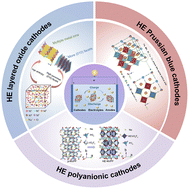Sodium-ion batteries (SIBs) are promising alternatives to lithium-ion batteries (LIBs) owing to abundant resources and cost-effectiveness. However, cathode materials face persistent challenges in structural stability, ion kinetics, and cycle life. This review highlights the transformative potential of high-entropy (HE) strategies that leveraging multi-principal element synergies to address these limitations via entropy-driven mechanisms. By establishing thermodynamic criteria for high-entropy materials (HEMs), we elucidate the universal principles whereby configurational entropy mitigates lattice distortion, suppresses phase transitions, and enhances Na+ diffusion kinetics via multi-element interactions. HE design demonstrates unique advantages for layered oxides, Prussian blue analogues (PBAs) and polyanionic cathode systems: it alleviates Jahn–Teller distortion through dopant synergy to stabilize layered structures; optimises ion migration channels by tuning exposed crystal facets; suppresses irreversible phase changes and mechanical strain to enable reversible structural evolution; and enhances redox reversibility via multi-site charge compensation among transition metals. Furthermore, reasonable design principles for the HE strategy in cathode materials for SIBs were proposed, along with the future expansion of theoretical calculations and the application of the HE strategy in the future. At the same time, potential challenges that may occur during this process and the current viewpoints and methods for solving these problems were emphasized. Overall, this review provides valuable guidance for the further exploration of the HE strategy in the field of SIBs.


